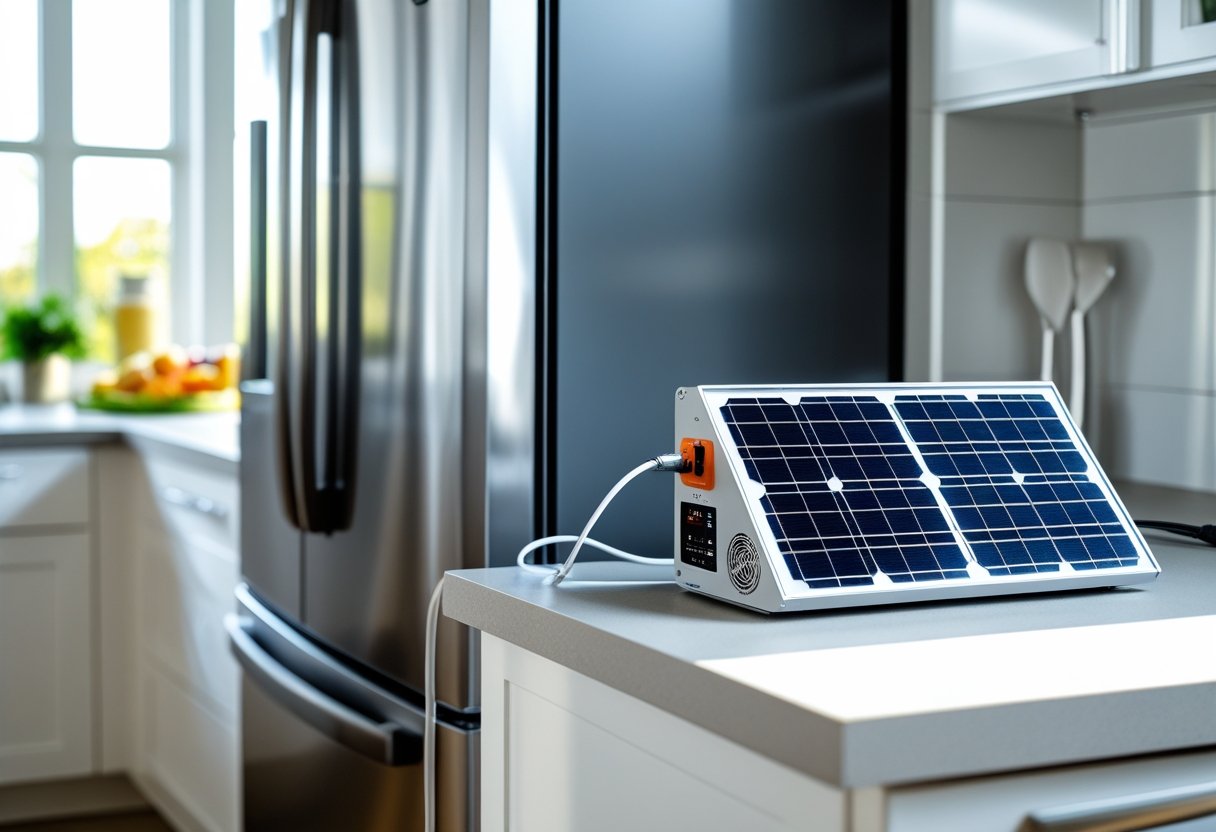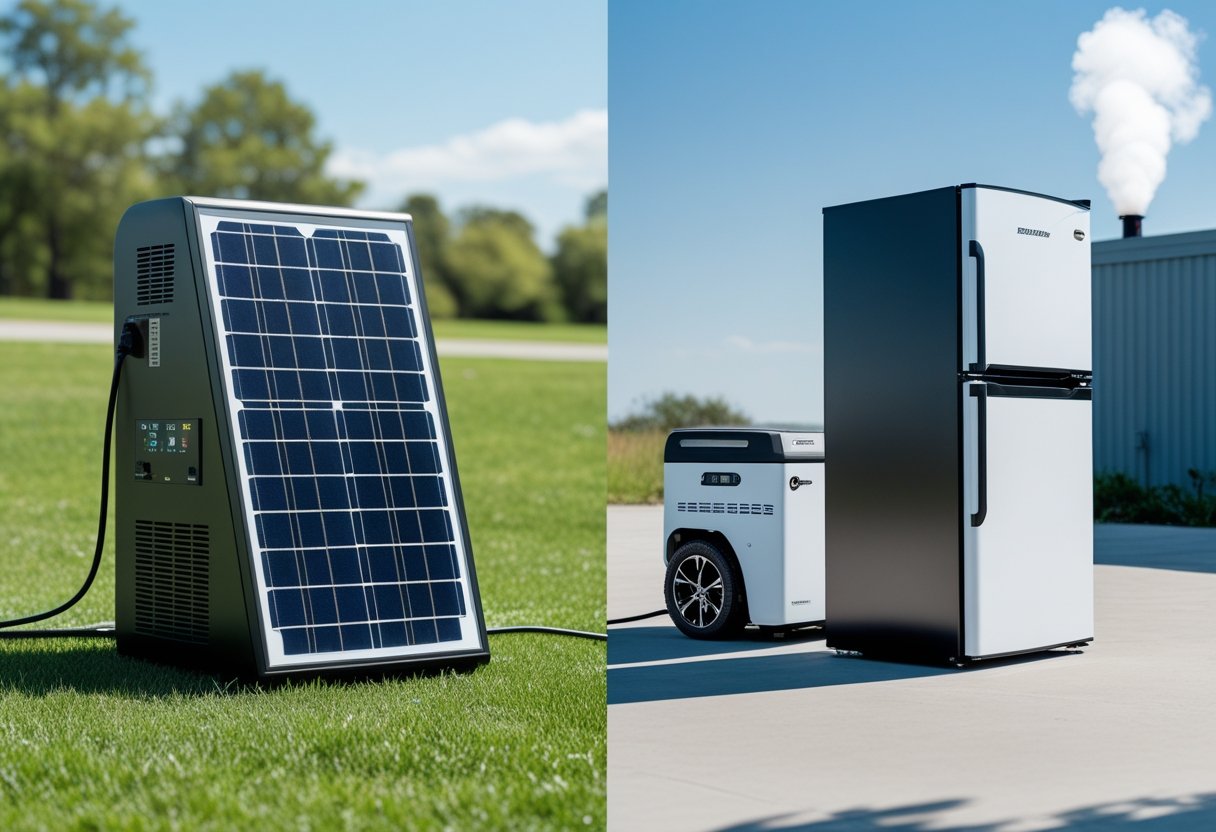A solar generator can power a refrigerator, but the ability to do so depends on the size and power output of the system. Most refrigerators require between 300 to 800 watts to operate smoothly, with occasional spikes during defrost cycles. Choosing a solar generator that can consistently supply this amount of power is critical to keeping a refrigerator running effectively.

Smaller refrigerators, like camping models, typically need less energy and can run well on more modest solar setups. Larger household refrigerators demand a more robust solar generator and battery storage to handle their higher and sometimes variable power needs. Understanding these requirements helps in selecting the right equipment for reliable refrigerator operation off-grid or during outages.
The key is balancing the wattage and capacity of the solar generator with the refrigerator’s consumption patterns. Systems from well-known brands with output in the 380 to 750 watts range are often recommended to cover typical refrigerator loads. More detailed guidance can be found in resources discussing solar power for refrigeration needs.
Can a Solar Generator Power a Refrigerator?
A solar generator can power a refrigerator, but it requires careful consideration of the refrigerator’s power consumption and the generator’s capacity. Understanding the watts needed to run the appliance continuously and during startup is essential for reliable operation.
How Much Power Does a Refrigerator Need?
Refrigerators typically need between 300 and 800 watts to run smoothly. Startup wattage can be higher, often 2-3 times the running power, due to the compressor motor. A small or medium refrigerator usually consumes closer to 300-500 watts, while larger or older models may reach 700-800 watts.
Power usage varies daily depending on the refrigerator’s efficiency and ambient temperature. On average, a refrigerator may use around 1000 to 1500 watt-hours (Wh) per day. Accurate knowledge of both running and startup watts is key to choosing the right solar generator.
Matching Solar Generator Capacity to Refrigerator Requirements
A solar generator with a capacity of around 4000 Wh is typically needed to power a refrigerator for a full day. This ensures enough energy storage for continuous operation and startup surges.
It’s important to choose a generator that can supply consistent power above the refrigerator’s peak wattage. For example:
- Running watts: 300-800W
- Startup watts: 600-1600W
Generators like Goal Zero or Jackery are popular because they can handle these loads. The solar generator should also have an inverter that supports surge wattage without damage. Monitoring estimated daily consumption alongside generator capacity guarantees longer, uninterrupted refrigeration How Much Power Does a Refrigerator Need?.
Key Solar Generator Components and How They Work
A solar generator consists of essential parts that work together to convert sunlight into usable electricity and store it efficiently. Understanding these components helps clarify how a solar generator powers devices like refrigerators reliably.
Role of Solar Panels and Inverters
Solar panels capture sunlight and convert it into direct current (DC) electricity. Their efficiency depends on factors such as panel wattage, sun exposure, and panel quality. For example, a 100-watt solar panel can supply a limited amount of power, which may impact how long it can run a refrigerator.
The inverter converts the DC electricity from the solar panels or battery into alternating current (AC) electricity. Since most household appliances, including refrigerators, operate on AC, the inverter’s capacity directly affects the type and quantity of devices the solar generator can support. A powerful inverter rated around 2,500 watts or more can handle larger refrigerators and freezers. Without an efficient inverter, the electricity generated by solar panels cannot be used practically.
Types of Batteries Used in Solar Generators
Batteries store the energy collected by solar panels so devices can run even without sunlight. The two main battery types in solar generators are lithium-ion and lead-acid batteries.
-
Lithium-ion batteries offer higher energy density, longer life cycles, and faster charging times. They are lightweight, making solar generators more portable. Lithium batteries also maintain voltage better under load, which is crucial for consistent refrigerator operation.
-
Lead-acid batteries, including AGM (Absorbent Glass Mat) types, are more affordable but bulkier and heavier. They have shorter lifespans and slower charging rates. AGM batteries are sealed and require less maintenance than flooded lead-acid types but are less efficient overall compared to lithium.
Choosing the right battery affects run time, durability, and the overall solar power system’s effectiveness.
Practical Applications for Running Refrigerators on Solar Generators
Running a refrigerator on a solar generator is practical in various situations where access to conventional power is limited or unreliable. It requires choosing an appropriately sized battery bank and understanding the energy demands of the refrigerator, including startup surges and ongoing consumption.
Emergency Power for Homes
Solar generators provide a reliable backup power source during outages. A typical home refrigerator uses about 100–800 watts during startup, depending on size, so the generator must supply enough surge power briefly.
Pairing the generator with a sufficiently large battery bank extends runtime through extended power failures. It is also important to manage other high-draw appliances, as the refrigerator often runs along with additional critical loads like lights or medical devices.
Solar generators are silent and do not emit fumes, making them preferable to propane or gas during emergencies indoors. The addition of small inverter air conditioning units rated around 15k BTU requires significantly larger systems and may not be feasible with smaller solar generators.
Off-Grid and Boondocking Scenarios
In off-grid living or boondocking, solar generators enable refrigeration without grid connection. Since access to fuel might be limited, solar generators paired with solar panels provide sustainable energy ideal for extended stays.
Energy usage must be planned carefully. Refrigerators consume continuous power to maintain temperature, so energy-efficient models or those designed for low power consumption are preferred. Battery capacity should support overnight loads without solar input.
Dry camping without hookups often means managing multiple power demands including lights, small appliances, and possibly a water pump. The solar generator system must balance powering a refrigerator with these loads to avoid rapid battery depletion.
RV, Airstream, and Camp Use
Solar generators are popular in RVs, Airstreams, and camp setups for their quiet operation and portability. They easily power typical RV refrigerators, which vary in power draw but often require less surge capacity than home models.
In smaller mobile setups, integrating a solar generator with the existing battery bank allows running refrigeration alongside other essentials like lights and fans. Careful load planning ensures the battery bank is not overtaxed, especially during cloudy days when solar input reduces.
Use in RVs with 15k BTU A/C units is more complex, as the air conditioners demand high wattage. Most solar generators suitable for refrigeration alone are insufficient for air conditioning without large battery banks and multiple panels.
Comparing Solar Generators and Gas Generators for Refrigerators

Solar generators and gas generators differ significantly in how they deliver power to run refrigerators. Understanding their efficiency, reliability, environmental effects, and noise levels helps determine which option meets specific needs.
Efficiency and Reliability
Solar generators depend on sunlight to charge their batteries, which can limit continuous power availability during cloudy days or at night. Their efficiency varies based on panel size and sunlight exposure, making backup power or larger capacity necessary for reliable use.
Gas generators offer consistent power output as long as fuel is available. They can easily handle the surge power refrigerators need at startup, typically around 2-3 times their running wattage. However, gas generators require regular maintenance and fuel storage.
In terms of power delivery:
- Solar generators excel in quiet, zero-emission operation but may face downtime without adequate sunlight.
- Gas generators provide uninterrupted power but consume fuel and produce emissions.
A 1000-watt solar generator can generally power a mid-size refrigerator, but gas generators usually supply higher wattage more consistently for larger appliances (jackery.com).
Environmental Impact and Noise
Solar generators produce no emissions during operation, making them environmentally friendly. They operate silently, which is ideal for residential areas or campsites where noise restrictions apply.
Gas generators emit carbon monoxide and other pollutants due to fuel combustion. Their exhaust affects air quality and requires placement in well-ventilated outdoor spaces to prevent hazards. Noise levels from gas generators are substantially higher, often producing 60-70 decibels or more, which can be disruptive.
| Feature | Solar Generator | Gas Generator |
|---|---|---|
| Emissions | Zero | High (carbon monoxide, CO2) |
| Noise Levels | Near silent | Loud, 60-70+ dB |
| Fuel Dependency | No (relies on sunlight) | Yes (gasoline or propane) |
| Environmental Suitability | Ideal for eco-sensitive areas | Less eco-friendly |
This contrast makes solar generators the preferred choice where quiet, clean energy is important, while gas generators remain useful for high-demand, fuel-reliable environments (freshlycharged.com).
Top Pick: Jackery Explorer 1000
Reliable, portable, and powerful — ideal for blackouts, camping, and off-grid living.
Check Price on Amazon →